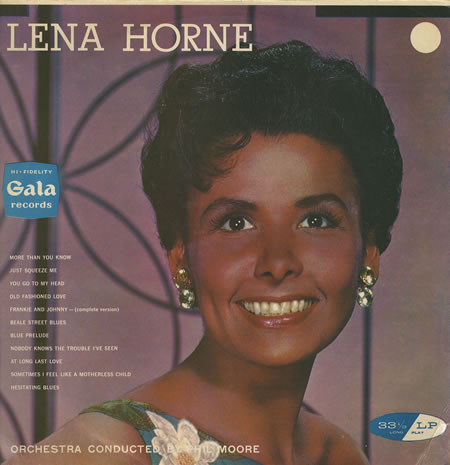LENA HORNE
-
 Toshiko Akiyoshi
Toshiko Akiyoshi - Geri Allen
- Andrews Sisters
- Angela Andrews
- Lil Harden Armstrong
- Dorothy Ashby
- Pearl Bailey
- Beverly Barkley
- Karen Briggs
- Ruth Brown
- Diane Cameron
- Betty Carter
- Joan Cartwright
- Kim Clarke
- Gloria Coleman
- Alice Coltrane
- Sasha Daltonn
- Dorothy Donegan
- Ella Fitzgerald
- Gloria Galante
- Rita Graham
- Jace Harnage
- Billie Holiday
- Bertha Hope
- Shirley Horn
- Lena Horne
- Alberta Hunter
- Jus' Cynthia
- Sandra Kaye
- Emme Kemp
- Vinnie Knight
- Lavelle
- Peggy Lee
- Abbey Lincoln
- Melba Liston
- Gloria Lynne
- Tania Maria
- Marian McPartland
- Carmen McRae
- Mabel Mercer
- M'zuri
- Sandy Patton
- Trudy Pitts
- Cheryl Porter
- Shirley Scott
- Nina Simone
- Bessie Smith
- Dakota Staton
- Carol Sudhalter
- Monnette Sudler
- Sarah Vaughn
- Dinah Washington
- Ethel Waters
- Mary Lou Williams
Born in Brooklyn, New York, on June 30, 1917, Lena Horne is a singer and actress. Her mother was also an actress. Her grandmother was an activist who took Lena to the NAACP, the Urban League and the Ethical Culture Society.
At 16, Lena began working at Harlem's Cotton Club, first as a dancer, then in the chorus and later as a solo singer. She sang with orchestras, and was discovered, while singing with Charlie Barnet's orchestra. She sang in clubs in Greenwich Village and performed at Carnegie Hall.
Since 1942, Horne has appeared in films, on Broadway and she made many recordings. She's been honored with many awards for her lifetime of success.
Lena Horne's signature song, from a 1943 film of the same name, is "Stormy Weather." She published her memoirs, in 1950, as In Person and, in 1965, as Lena..
Lena
Horne passed away on May 9, 2010.
By VERENA DOBNIK, Associated Press Writer Verena
Dobnik, Associated Press Writer 18 mins ago
NEW YORK – Lena Horne,
the enchanting jazz singer and actress who reviled the bigotry that
allowed her to entertain white audiences but not socialize with them,
slowing her rise to Broadway superstardom, died Sunday. She was 92. Horne died at NewYork-Presbyterian Hospital, according to hospital
spokeswoman Gloria Chin. Chin would not release any other details. Horne, whose striking beauty and magnetic sex appeal often overshadowed
her sultry voice, was remarkably candid about the underlying reason for
her success. "I was unique in that I was a kind of black that white people
could accept," she once said. "I was their daydream. I had the
worst kind of acceptance because it was never for how great I was or what
I contributed. It was because of the way I looked." In the 1940s, she was one of the first black performers hired to sing
with a major white band, the first to play the Copacabana
nightclub and among a handful with a Hollywood contract. In 1943, MGM Studios loaned her to 20th Century-Fox to play the role of
Selina Rogers in the all-black movie musical "Stormy
Weather." Her rendition of the title song became a major hit
and her signature piece. On screen, on records and in nightclubs and concert halls, Horne was at
home vocally with a wide musical range, from blues and jazz to the
sophistication of Rodgers
and Hart in songs like "The
Lady Is a Tramp" and "Bewitched,
Bothered and Bewildered." In her first big Broadway success, as the star of "Jamaica"
in 1957, reviewer Richard Watts Jr. called her "one of the
incomparable performers of our time." Songwriter Buddy de Sylva
dubbed her "the best female
singer of songs." But Horne was perpetually frustrated with the public humiliation of
racism. "I was always battling the system to try to get to be with my
people. Finally, I wouldn't work for places that kept us out ... it was a
damn fight everywhere I was, every place I worked, in New York, in Hollywood,
all over the world," she said in Brian Lanker's book "I Dream a
World: Portraits of Black Women Who Changed America." While at MGM, she starred in the all-black "Cabin in the
Sky," in 1943, but in most of her other movies, she appeared only in
musical numbers that could be cut in the racially insensitive South
without affecting the story. These included "I
Dood It," a Red
Skelton comedy, "Thousands
Cheer" and "Swing Fever," all in 1943; "Broadway
Rhythm" in 1944; and "Ziegfeld
Follies" in 1946. "Metro's cowardice deprived the musical of one of the great
singing actresses," film historian John Kobal wrote. Early in her career Horne cultivated an aloof style out of
self-preservation, becoming "a woman the audience can't reach and
therefore can't hurt" she once said. Later she embraced activism, breaking loose as a voice for civil
rights and as an artist. In the last decades of her life, she rode
a new wave of popularity as a revered icon of American
popular music. Her 1981 one-woman Broadway
show, "Lena
Horne: The Lady and Her Music," won a special Tony
Award. In it, the 64-year-old singer used two renditions — one
straight and the other gut-wrenching — of "Stormy
Weather" to give audiences a glimpse of the spiritual odyssey
of her five-decade career. A sometimes savage critic, John
Simon, wrote that she was "ageless. ... tempered like steel,
baked like clay, annealed like glass; life has chiseled, burnished,
refined her." When Halle Berry
became the first black woman to win the best
actress Oscar in 2002, she sobbed: "This moment is for Dorothy
Dandridge, Lena Horne, Diahann
Carroll. ... It's for every nameless, faceless woman of color who
now has a chance because this door tonight has been opened." Lena Mary Calhoun Horne, the great-granddaughter of a freed slave, was
born in Brooklyn June 30, 1917, to a leading family in the black
bourgeoisie. Her daughter, Gail
Lumet Buckley, wrote in her 1986 book "The Hornes: An
American Family" that among their relatives was a college
girlfriend of W.E.B. Du
Bois and a black adviser to Franklin D. Roosevelt.
Dropping out of school at 16 to support her ailing mother, Horne joined
the chorus line at the Cotton
Club, the fabled Harlem
night spot where the entertainers were black and the clientele white.
She left the club in 1935 to tour with Noble
Sissle's orchestra, billed as Helena Horne, the name she continued
using when she joined Charlie Barnet's white orchestra in 1940.
A movie offer from MGM came when she headlined a show at the Little
Troc nightclub with the Katherine
Dunham dancers in 1942.
Her success led some blacks to accuse Horne of trying to
"pass" in a white world with her light complexion. Max Factor
even developed an "Egyptian" makeup shade especially for the
budding actress while she was at MGM.
But in his book "Gotta Sing Gotta Dance: A Pictorial History of
Film Musicals," Kobal wrote that she refused to go along with the
studio's efforts to portray her as an exotic Latin American.
"I don't have to be an imitation of a white woman that Hollywood
sort of hoped I'd become," Horne once said. "I'm me, and I'm
like nobody else."
Horne was only 2 when her grandmother, a prominent member of the Urban
League and the National
Association for the Advancement of Colored People, enrolled her in
the NAACP. But she
avoided activism until 1945 when she was entertaining at an Army base and
saw German prisoners of war sitting up front while black American soldiers
were consigned to the rear.
That pivotal moment channeled her anger into something useful.
She got involved in various social and political organizations and —
along with her friendship with Paul
Robeson — got her name onto blacklists during the red-hunting
McCarthy era.
By the 1960s, Horne was one of the most visible celebrities in the civil
rights movement, once throwing a lamp at a customer who made a racial
slur in a Beverly Hills restaurant and in 1963 joining 250,000
others in the March on
Washington when Martin
Luther King Jr. gave his "I Have a Dream" speech. Horne
also spoke at a rally that same year with another civil rights leader,
Medgar Evers, just days before his assassination.
It was also in the mid-'60s that she put out an autobiography,
"Lena," with author
Richard Schickel.
The next decade brought her first to a low point, then to a fresh burst
of artistry.
She had married MGM music director Lennie Hayton, a white man, in Paris
in 1947, after her first overseas engagements in France and England. An
earlier marriage to Louis J. Jones had ended in divorce in 1944, after
producing daughter Gail and a son, Teddy.
In the 2009 biography "Stormy Weather," author
James Gavin recounts that when Horne was asked by a lover why she'd
married a white man, she replied: "To get even with him."
Her father, her son and her husband, Hayton, all died in 1970-71, and
the grief-stricken singer secluded herself, refusing to perform or even
see anyone but her closest friends. One of them, comedian Alan
King, took months persuading her to return to the stage, with
results that surprised her.
"I looked out and saw a family of brothers and sisters," she
said. "It was a long time, but when it came I truly began to
live."
And she discovered that time had mellowed her bitterness.
"I wouldn't trade my life for anything," she said,
"because being black made me understand."
More Lena Horne on this site:
Related Resources:
Legendary singer Lena Horne dies




